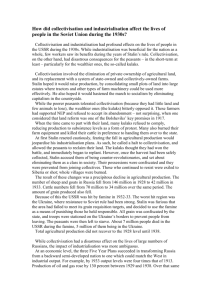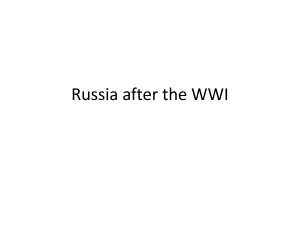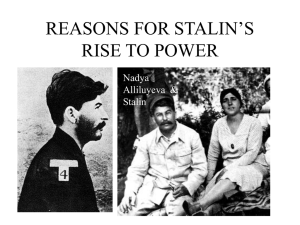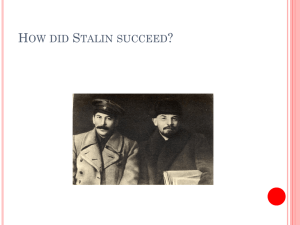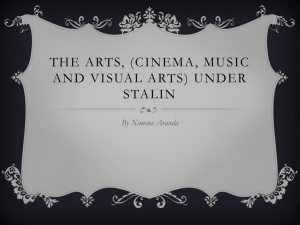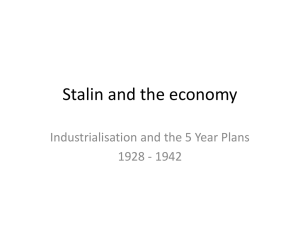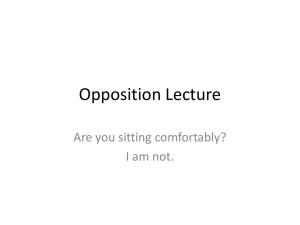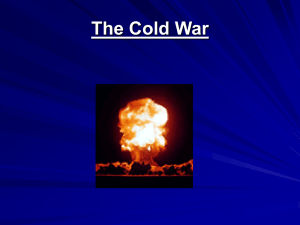Stalin and his collectivisation policy
advertisement
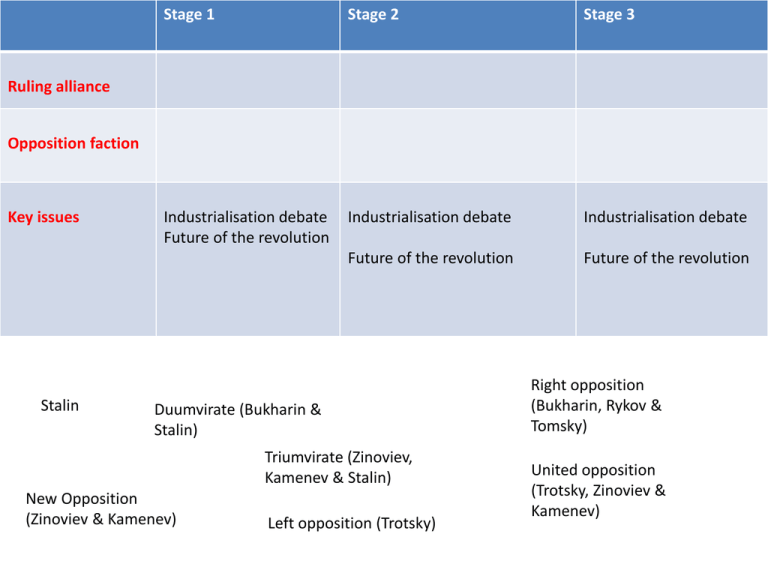
Stage 1 Stage 2 Stage 3 “1994 was the first year without Lenin. The Communist Party and the Soviet people continued their creative work of building socialism under Ruling alliance Comrade Stalin’s leadership. Comrade Stalin rallied the Party around its Central Committee and mobilised for the struggle to build socialism in the USSR” Stalin 1947 Opposition faction Key issues Stalin Industrialisation debate Future of the revolution Industrialisation debate Industrialisation debate Future of the revolution Future of the revolution Duumvirate (Bukharin & Stalin) Triumvirate (Zinoviev, Kamenev & Stalin) New Opposition (Zinoviev & Kamenev) Left opposition (Trotsky) Right opposition (Bukharin, Rykov & Tomsky) United opposition (Trotsky, Zinoviev & Kamenev) Stage 1 Stage 2 Stage 3 Ruling alliance Triumvirate (Zinoviev, Kamenev & Stalin) Duumvirate (Bukharin & Stalin) Stalin Opposition faction Left opposition (Trotsky) New Opposition (Zinoviev & Kamenev) Right opposition (Bukharin, Rykov & Tomsky) Key issues United opposition (Trotsky, Zinoviev & Kamenev) Industrialisation debate Industrialisation debate Industrialisation debate Future of the revolution Future of the revolution Future of the revolution Stage 1 Stage 2 Stage 3 Ruling alliance Triumvirate (Zinoviev, Kamenev & Stalin) Duumvirate (Bukharin & Stalin) Stalin Opposition faction Left opposition (Trotsky) New Opposition (Zinoviev & Kamenev) Right opposition (Bukharin, Rykov & Tomsky) United opposition (Trotsky, Zinoviev & Kamenev) Key issues Industrialisation debate Industrialisation debate Industrialisation debate Future of the revolution Future of the revolution Future of the revolution To what extent did Stalin use the same methods to destroy all his opponents? E.g. Ideological methods, manipulation of the party machine, devious tactics. How far do you agree that Stalin’s ability to manipulate the Party machine was the key to his success in the leadership struggle? Stalin in power The Revolution from above 1928 - 41 What do you know about Stalin and the USSR during his time in power? • Modernise Soviet society & economy - creating a truly Communist and prosperous society • Ensure the national security of the USSR (After the death of Lenin Stalin had called for ‘Socialism in One Country’ ) • Maintain his position as leader What were Stalin’s main policies 1928 - 53? • Collectivisation • The Five Year Plans • The Cultural Revolution (inc. the cult of personality & policies towards women, religion, education & young people) • The Purges • Leading USSR during ‘The Great Patriotic War’ (1941-45) “Building socialism in the countryside.” What economic problems were created by the NEP in the late 1920s? Why did Stalin launch his collectivisation policy? How far did collectivisation change over time? How far did collectivisation meets its aims? What economic problems were created by the NEP in the late 1920s? • Using the source handout answer the question above. Why did Stalin launch his collectivisation policy? Economic Aims Ideological aims Political aims Grain procurement crisis 1927-9 What form did collectivisation take? How far did collectivisation change over time? Radical policy reversed Radical policy Radical policy reintroduced Emergency measures Twenty – five thousand ers “dekulaki sation” Liquidati on of the Kulaks Forced collectivis ation Impact of forced collectivisatio n ---> The Party retreats/ “Dizzy with Success” ---> Policy suspended. Collectivi sation resumes Famine The collectivisation campaign in the USSR, 1930s. The slogan reads: "We kolkhoz farmers, on the basis of complete collectivisation, will liquidate the kulaks as a class." (THINK: Who is likely to have organised such a demonstration?) What impact did collectivisation have? Positive Rural areas Industrialisation + urbanisation Political consequences. Negative Number of collective farms Year Percent of farmsteads in collective farms Percent of sown area in collective use 1927 14,800 0.8 – 1928 33,300 1.7 2.3 1929 57,000 3.9 4.9 1930 85,900 23.6 33.6 1931 211,100 52.7 67.8 1932 211,100 61.5 77.7 1933 224,500 65.6 83.1 1934 233,300 71.4 87.4 1935 249,400 83.2 94.1 1936 – 90.5 98.2 1937 243,700 93.0 99.1 1938 242,400 93.5 99.8 1939 235,300 95.6 – 1940 236,900 96.9 99.8 PRODUCTION: Grain 1928 = 73.3 million tons 1934 = 67.6 million tons Cattle 1929 = 70.5 million 1934 = 42.4 million Pigs 1928 = 26 million 1934 = 22.6 million Sheep and goats 1928 = 146.7 million 1934 = 51.9 million How far did collectivisation meets its aims? Successes Economic Aims Ideological aims Political aims Failures HOW FAR IS IT ACCURATE TO DESCRIBE STALIN’S POLICY OF COLLECTIVISATION AS A FAILURE? (30 MARKS) CONSEQUENCES? • 10,000,000 people exiled. • Those who remained endured hardship. Unrealistic targets. Anger and resentment towards the government. This led to a DROP in productivity. • The Kulaks were hard-working/successful, but had been exiled. Production fell. • 1933 harvest was 9,000,000 tonnes less than that of 1926. • Few farms acquired machinery. (too expensive). • BUT......by 1941 all farms were collective. INDUSTRIALISATION? • Aim: to provide grain to export to raise funds for industrialisation. • SUCCESS: more exported. • Standard of living fell for industrial workers. • FAILURE: urban workers no better off. • Unity between the peasants and workers? • FAILURE: urban workers (propaganda) anger at peasants. • Growth of urban areas • SUCCESS: Urban population in cities grew. POLITICAL CONSEQUENCES • Surprisingly, the chaos united the Party behind their leader! • Kulaks and peasants blamed for problems. • Many even supported the hard line against the peasants. • Stalin achieved his personal ambition...Russia was urbanised and grain procured was sold abroad. • BUT collectivisation was ruthless.
